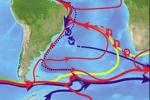GTS Google Earth Layer for Global Marine and Meteorological Observations
The Physical Oceanography Division at NOAA/AOML manages and coordinates the operational data collection of the Global Ocean Observing System (GOOS). By utilizing the GTS Google Earth Layer, recent marine and meteorological observations collected in the Global Telecommunications System (GTS) can now be viewed and explored on Google Earth.
Please acknowledge AOML as the source of the applications below when using them. For updates or other information contact: Dr. Joaquin Trinanes or Dr. Gustavo Goni. To download the Google Earth layer (updated weekly), which can be viewed in Google Earth Software, click here. For a free copy of Google Earth, click here. To view this application on a web browser using the Google Earth browser plugin (Win/Mac), click here.





